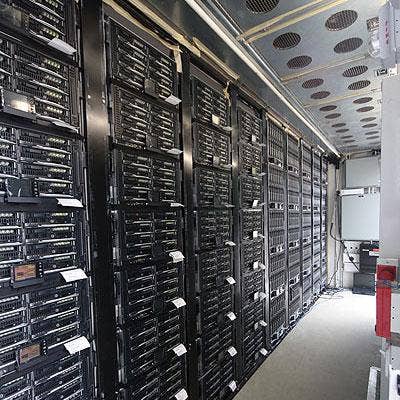6 Drivers Of The 'Storage Infrastruggle' And How To Manage Them

Drivers Of The 'Storage Infrastruggle'
Jon Toigo, storage analyst and CEO of Toigo Partners Int'l., used his Wednesday COMDEXvirtual presentation to outline the six primary challenges confronting the building of storage infrastructures.
Those challenges, part of what Toigo calls the "storage infrastruggle," need to be addressed before a storage infrastructure is implemented to mitigate the risk to storage budgets down the road.
"From a budgetary perspective, it is the cost of storage that threatens to bankrupt our efforts," Toigo said. "That is, unless we understand the drivers of the challenge and think strategically about what we want to do with them."

Challenge No. 1: Unmanaged Data Growth
Toigo said there is no disputing the fact that data is growing quickly. However, he said, the amount of that growth stemming from useful data is limited.
On the average, according to a Toigo study, 30 percent of the data on a disk drive is active data, 40 percent is archival or inert data that is seldom accessed, 15 percent is wasted space waiting to be reclaimed, 10 percent is orphaned data from servers or users no longer at a company, and 5 percent is contraband data such as an administrators' .MP3 files.
"When you think about it, a little data hygiene, and a little data archiving, could go a long way toward reclaiming up to 70 percent of the capacity of spindles that we already own," he said. "But nobody wants to talk about cleaning out the junk drawer."

Challenge No. 2: The Impact Of Server Virtualization
The impact of server virtualization on storage is often masked, Toigo said. For instance, IDC last year estimated that there were 11 exabytes of storage worldwide, and that it would grow 30 percent to 40 percent annually to reach 46 exabytes by 2014.
However, IDC this year revised the estimation, saying growth would be about 300 percent in companies with heavily virtualized environments, bringing the total to 168 exabytes in 2014. That was followed by Gartner, which estimated that storage in virtualized environments would lead to a 650 percent growth in storage to 202 exabytes by 2014.
"What you assume from this is that server virtualization seems to be having a significant impact on how much storage we need to deploy," Toigo said. "That's not good news."

Challenge No. 3: The Impact Of The 'Disk Everywhere' Dogma
Toigo said the storage industry has adopted a "Disk Everywhere" dogma, with businesses adopting disk-to-disk backups and a penchant for storing more and more data as files rather than as blocks, both of which unnecessarily increase the amount of data stored on hard disks.
"So we're seeing the amount of space used for file storage increasing almost exponentially, and we see the amount of disk storage being used to replicate disk storage also increasing exponentially," he said.
So why is that an issue? Toigo said it is related to Challenge No. 4 on the next page.

Challenge No. 4: Storage Is Oversubscribed, Underutilized, Overbuilt
Toigo said data used to be stored in a nice hierarchy of different media: frequently accessed data on fast disks or SSDs; less accessed data on high-capacity, low-cost disks; and seldom or never accessed data on low-cost tape, optical disc or similar technologies.
Today, however, customers are buying tiered storage arrays where data sits on multiple types of storage media within one device, governed by an algorithm that uses how often that data is accessed to determine on which class of disk it should be stored. This, combined with the use of deduplication or MAID (massive arrays of idle disks) technologies to store seldom accessed data, increases the amount of data stored on disk and unnecessarily increasing storage costs, he said.
"This is part of the disk-everything mentality that's worked out really well for hardware vendors," he said. "But I don't know that it's done a great deal of good for consumers."

Challenge No. 5: Storage Cloud Hype Is Deafening
Beware of research showing how fast cloud storage is being adopted, Toigo said.
He cited an Info-Tech Research Group report, which stated that 2011 adoption of cloud storage was 326 percent higher than in 2010. "That sounds pretty remarkable," he said. "That sounds like storage clouds are high and to the right, and their owners all have to wear shades because their futures are so bright."
However, Toigo said, the study's fine print showed that 51 percent of respondents said no cloud storage meets their business requirements; 70 percent are concerned about cloud storage service availability; 84 percent are concerned about cloud storage costs; and 83 percent are concerned about cloud storage security.
That same organization also found that 88 percent of cloud storage is being used by PaaS (Platform-as-a-Service) providers for their own cloud-based servers.

Challenge No. 6: Tactical Decision-Making Doesn't Help
A strategic approach, not a tactical approach, to managing data growth and the related costs and complexities is required, but much of the data IT managers use to make storage decisions does not support the strategic approach, Toigo said.
For instance, he said, articles in widely read business magazines tell managers that the cloud is their ticket to the front office. Also, IT people can get lazy in their choices because the storage vendors may go to management to get on an approved list of limited storage product choices.
Also, Toigo again warned about shoddy research. In the report about 326 percent growth in storage clouds, the research organizer based it on data from a mere 99 respondents. In another widely quoted study, the sample size was only 17 respondents, he said.
"The marketing around storage in the cloud falls into the category of 'silver-bullet' solutions," he said.

The Bottom Line?
Toigo suggested a number of strategies to overcome the six "storage infrastruggle" challenges including:
* Delay new storage purchases by adding compression, deduplication, and other data-squeezing technologies to buy time for strategic thinking and planning.
* Clean out the "junk drawer" by identifying data not accessed for 90 days to shame managers into migrating it to tape.
* Stop virtualizing storage according to hypervisors and focus more on virtualizing storage into pools, which can be accessed by multiple users.
* Use flash memory-based storage combined with fewer hard drives to increase performance and cut costs.
"The bottom line is, if we don't start adjusting the way we're thinking, this infrastructure that we're talking about may well wreak havoc and lead to the kind of career-ending disasters that we all want to avoid," he said.